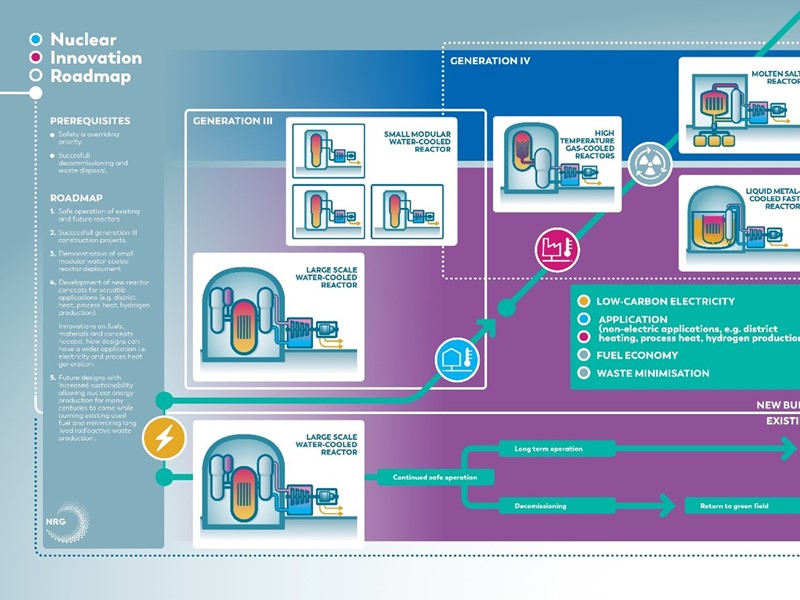We make use of cookies. When you click on agreed you are giving us your permission to do so. Please read our cookie statement for more information.
Innovation Roadmap
Innovation Roadmap on Nuclear Energy Development
26 April 2021
The call for carbon-free energy has never been so strong. On global as well as national levels there is a lack of consensus on how to meet the reduction targets. In the end we need a sustainable, reliable and affordable energy system in order to maintain our current living standards. Nuclear energy can be the missing link so there is a golden opportunity to make the difference.
However, in order to successfully implement nuclear energy in the longer term, the industry needs to innovate. Innovation on long term operation and decommissioning of existing reactors, innovations on successful Generation III projects and last but not least design innovations on advanced reactors for a wide range of applications.
The coherence of these technological developments is not always correctly understood. The Nuclear Innovation Roadmap below shows how the various innovations relate to each other.

Joost van den Broek
Director Consultancy and Services at NRG

Ferry Roelofs
Account manager Research & Innovation at NRG
Long Term Operation of existing reactors; a sound basis carbon-free energy.
Worldwide more than 400 reactors provide low-cost electricity on a continuous basis, day and night, wind or no wind.
Long term operation of existing reactors provides an enormous low-cost decarbonization potential, as is concluded by publications from e.g. NEA. Innovations on for example ageing of materials, maintenance, manufacturing of obsolete components, inspections and monitoring will improve safe long term operation.
The experience and innovation basis of the current fleet of reactors is fundamental for design, construction and operation of new reactors which can improve their performance and availability using the lessons learned from the current Long Term Operation programs.

Decommissioning and return to green field
Nuclear reactors that are taken out of operation, should be decommissioned safely and efficiently. Utilities have made reservations for this phase in the life-cycle since the start of construction and are responsible for the decommissioning of the reactor. Once decommissioning has successfully come to an end, the nuclear site will be handed back to green field, thus taking care of nature preservation. Germany is now leading innovations in Decommissioning & Dismantling projects. Thereby demonstrating the prerequisite for nuclear energy; successful greenfield delivery of nuclear sites after duty will support the case for new nuclear projects.
Generation III reactors: off the shelf technology
Europe and the United States were leading nuclear energy progression in the past with large, state-funded, construction programs. France is a leading example. Large series of PWR reactors were built in mind-blowing time schedules, with success. With 56 operating reactors, state-owned company EDF is still the largest utility in the world. Nowadays Asia and the Middle East are leading construction numbers of Generation III reactors with 16 units and 3 units under construction in China and UAE respectively. Current proven Generation III designs have a large potential.
They can provide huge amounts of safe, continuous and carbon-free electricity within a decade, the average time of a new build project from the decision to grid connection. The sector has been struggling with on time delivery of these large projects. Therefore, innovations on design simplification, project execution and financing are needed.
Large infrastructure projects have a tendency to delay. Such large projects are often first-of-a-kind and very complex, the nuclear context does not make it any easier. In this era where regulators, contractors and utilities are regaining competence, it takes time, dedication and commitment to be successful. But it can be done, considering the past.
Do we really want to solve the issues and what is and should be the role of governments? What can we learn from recent successful Generation III new build projects and what is their holy grail? Can Small Modular Reactors (SMRs) play a role, increasing the learning curve and reducing financial risk? We should keep in mind that with a modular approach, it is still possible to create large generating capacity. Time to market should be relatively short since light water concepts rely on existing technology. There will definitely be a market for SMRs!
Advanced reactors: the future promise
Advanced reactors have been subject of discussion for decades. Demonstration projects have been launched and significant technical progress has been made, but successful commercialization was not achieved yet. However, circumstances are different right now.
Technological developments on simulations, materials and manufacturing in the current nuclear and non-nuclear industry can bring new design solutions. For instance 3D printing of metallic components or materials qualifications and innovations.
Dedication of scientists, bright young students and startups have never been so strong to make it happen. Last but not least, there is strong public support. The advanced reactors can and probably will provide a flexible source of energy, not limited to electricity alone. Low and high temperature heat can be used as process heat for various applications. Full decarbonization will create an immense demand for synthetic fuels for e.g. aviation and shipping.
Many innovations are needed to successfully implement these new technologies. The existing licensing framework has to be re-assessed to enable construction and operation of these new reactors. This will only be successful if there is a joint effort between industry and regulators. The good news is that there is progress. The IAEA SMR regulators forum erected in 2015 is a good example.
Conclusion
The Nuclear Industry faces enormous challenges to maintain its social task; to provide safe, carbon free and reliable energy. Experience exchange between LTO, New Build and Advanced Reactors is the key to success. This is exactly the target of the Nuclear Innovation Conference!
